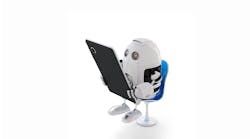by Mark E. Hyman, DDS, MAGD
In the 26 years I have been in practice, my team and I have experienced many technological advances. Some have been highly significant and quite complex, with steep learning curves. Others have been very affordable and easy to adopt, while making a very positive difference in the way we care for our patients.
Today I refer to those exceptional, paradigm-shifting, level-jumping, “aha” moments and “wow” factor advances as “game changers.” They revolutionize the way we practice and raise us up into another realm. If you were to poll all the forward-thinking and innovative dental thought leaders in the nation, I believe many of their “top 20 game changers” would be similar, if not open to some spirited debate.
Keeping abreast of technological advances is a critical activity in the dental profession, and one many of us pursue by attending continuing education seminars and hands-on training sessions, reading industry publications, visiting websites, participating in conferences, and now, viewing webinars. The economy continues to cause some practices to reconsider their priorities, but it is critical that proactive practices continue to invest in those innovations that will yield optimal care to patients and produce a high return on the investment of time and money. The best response to “If it isn’t broken, don’t fix it” is “If it makes us better, let’s break it!”
Be early adopters
In consumer marketing terms, my team strives to establish our practice as “early adopters” with respect to improvements in care and performance. Our criteria for assessing new technology are quite simple: Will this enhance the quality of the care we provide our patients or somehow improve their experience with us? If the answer is an affirmative yes to either of these considerations, we will begin implementing these game changers. Whether technological advances present themselves in the form of new equipment, updated procedures, or patient care initiatives, we are willing to integrate new developments that make sense without fear of failure.
This past April, I was introduced to the newest game changer — Onset® from Onpharma® — when I spoke at the Dugoni School of Dentistry, University of the Pacific alumni meeting in San Francisco. One of my top dental heroes, Dr. Craig Yarborough and Dr. Dennis Shinbori, introduced me to one of his former students, Dr. Mic Falkel, founder and chief medical officer of Onpharma. Dr. Falkel was sharing his new technology with those in attendance. He explained the chemistry involved in the development of Onset. His research found that one of the key reasons a local anesthetic will cause discomfort to a patient is its acidity.
The basic concept of Onset is quite simple to understand. Once the local anesthetic is connected to the Onset mixing pen, a volume dispenser dial can be adjusted to transfer the desired amount of sodium bicarbonate solution from the pen to the local anesthetic cartridge, changing the chemical makeup of the anesthetic from acidic to neutral. The stinging effect that patients experienced is removed due to the lack of acidity in the anesthetic.
After I analyzed the relatively small investment in adopting this technology — and the short learning curve — I felt my team and I had a game changer on our hands. This new technique clearly would result in a positive impact on the patient experience, less local anesthetic use, an increase in productivity through the faster onset, and a significant return on a minimal investment. In fact, one of my colleagues whom I hold in very high regard performed a time and motion study with Onset and told me emphatically that Onset is allowing her clients to gain one hour in their schedules each day.
Onset helps increase productivity
A common challenge for those who teach CE courses is to find a way to help our colleagues increase productivity. We have only a finite amount of “doctor only” time in our daily schedules. If Onset saves the practice one hour a day, and you simply add one filling at $100 in that one hour a day — and consider most dentists work 200 days a year — making a change to Onset would add $20,000 to the bottom line. Alternatively, in these challenging times with an average variable overhead of $250 per hour, a practice using Onset can add about $4,000 per month to its bottom line. Onset is a game changer that I will be sharing during my seminars in 2012!
Tina Calloway, CDA, a member of our team for 13 years, has been helping me manage the level of bicarbonate with Onset since I brought it back from California in April, and she has high praise for this product. “It is very easy to use,” she says. “I simply connect the anesthetic carpule to the mixing pen, press a button to deliver the precise amount of bicarbonate (.18 ml), and the cartridge is pH neutral. The process takes me about 10 seconds right before I load the cartridge into the syringe and hand it to the doctor. I think the best part of this new innovation is the overwhelmingly positive feedback from our patients.”
Nearly every patient with whom we have used Onset has had great reactions. It is typical to hear feedback such as, “It doesn’t burn like it used to,” or “I didn’t feel anything,” or my favorite, “I’m so glad this was invented because it takes away the sting of the needle that I dreaded most about my visit to the dentist!”
If Onset, representing one simple change in procedure, can completely remove a patient’s fear of treatment and minimize discomfort while shortening my schedule, shouldn’t it be included among the top game changers of today’s dental practices?
Mark E. Hyman, DDS, MAGD, practices full time in Greensboro, N.C. He is an adjunct associate professor at the UNC School of Dentistry, a Pankey Institute instructor, and speaks on practice enhancement, complex treatment-planning, team-building, and the modern high-tech/high-touch private practice. Contact Dr. Hyman to speak to your study club or dental meeting by emailing him at [email protected].
Speaking at the Hinman 100th Dental Meeting March 22-24, 2012
Past DE Issues





